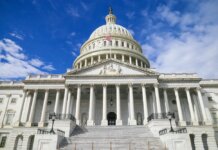Although the commercial real estate sector is showing hints of stabilization, a full recovery is still far away, regulators and analysts say. In a hearing Friday, the Congressional Oversight Panel (COP), a federal watchdog agency, examined the impact of commercial real estate on bank stability.
Jamie Woodwell, the Mortgage Bankers Association's vice president of commercial real estate research, called property values ‘the most significant factor at play,’ in his prepared testimony. According to separate testimony from Foresight Analytics' managing director, Matthew J. Anderson, recent figures show that commercial property values have decreased by about 42% since their peak in late 2007.
Of particular concern, Anderson said, is the volume of underwater loans set to mature in coming years. Foresight estimates that as many as half of the loans maturing between now and 2015 are underwater, with as much as $251 billion upside-down by 20% or more.
The commercial mortgage-backed securities (CMBS) market, which once accounted for more than a quarter of all commercial real estate financing, is returning at a slow pace, meaning the sector will continue to rely heavily on depositories for new credit, added Sandra Thompson, the Federal Deposit Insurance Corp.'s (FDIC) director of supervision and consumer protection.
FDIC-insured institutions have been particularly exposed to the commercial real estate downturn. Of the 322 banks that have failed since 2008, more than 86% had commercial real estate concentration levels that exceeded levels defined in 2006 guidance from regulators, Thompson said. In turn, banks have tightened their standards considerably.
‘While this more conservative approach to underwriting may mean that some borrowers who received credit in past years will have more difficulty receiving credit going forward, it should not mean that creditworthy borrowers are denied loans,’ Thompson said.
Thompson additionally conceded federal bank regulators ‘could have been more
aggressive in their approach to institutions with the riskiest CRE exposures, especially in real estate development lending.’
She explained that the FDIC has upped its supervisory duties, including requiring more detailed reporting from insured institutions and expanding its use of supervisory visitations to banks with high concentrations of commercial real estate loans. She also said that inter-agency guidance on commercial mortgage workouts, provided by agencies in 2009, have encouraged ‘prudent and pragmatic’ loan workouts.
However, the recovery of the commercial sector ultimately hinges on the overall U.S. economy's bouncing back, Woodwell said.
‘The most significant factor in the performance of commercial real estate markets during the recent downturn – and in coming quarters – has been, and will be, the performance of the broader economy,’ he said. ‘Vacancy rates at commercial properties rose as jobs were lost, consumers pulled back in spending and household growth contracted. Likewise, capitalization rates on commercial properties rose as investor yields across a range of investment options grew.’
SOURCE: Congressional Oversight Panel













